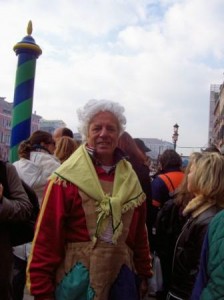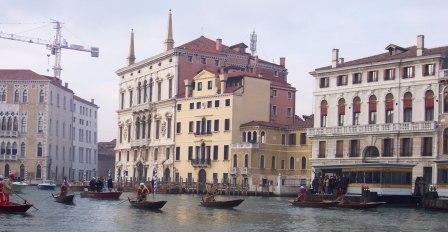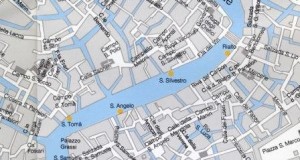Out in the countryside you may only need some twigs, a match, and a jug of wine to make a party, but in Venice you’ve got to have boats. Boats that race, to be precise. And before she finally moves on, the Befana has to get rowing.

Ever since darkest antiquity sacred festivals have included some form of athletic competition. The Olympic Games spring to mind, but even the tiniest hamlet lost in the mountains may still organize a foot race, or horse race, or something else, when their saint’s day comes around. In ancient Greece some events, such as the funeral of a woman, would require a race reserved for women.
On Epiphany they held the 32nd edition of the Regata de le Befane, the race of the Befanas, in the Grand Canal. It’s fun to watch, doesn’t take long, there are free refreshments — they even hang an enormous calza caena, filled with only God and they know what, from the Rialto Bridge. In fact the only people who take it seriously in any way are the five Befanas.
Who are these hags? Men over 50, members of the Bucintoro rowing club, who have passed the eliminations for a place in the five-boat line-up. The event is limited to five because more can’t fit abreast in the Grand Canal. It’s just a sprint; the official schedule allots fifteen minutes to the race, but it really only takes about five. Maybe eight. But they are minutes filled with drama, at least for the participants.
The boats: Mascaretas, each rowed by one person with one oar.
The course: The aforementioned Grand Canal, from the major curve in the Grand Canal (the “volta de Canal”) at the Palazzo Balbi between the Accademia and Rialto Bridges to just before the Rialto Bridge.

The garb: Strictly Befana, the men decked out in wigs and Dogpatch skirts and crocheted shawls, with scraggly brooms and weird teeth (often their own).
It takes a while to get them reasonably lined-up — it’s a “flying” start, which means each keeps inching forward while waiting for the starting gun. This gambit often means a longish wait as the judge attempts to make them stay even, at least for a second. They also have to wait for a break in the vaporettos coming and going, which isn’t so easy nowadays considering how many there are at any given point/moment.
They’re off! The tide was going out — good, in a way but, as with all Venetian races, the luck of the draw which determines the positions in the starting line-up was a powerful factor in the outcome. Because while they were all rowing against the tide, due to the shape of the canal some had more of it against them than others. The man closest to the shore, if you will, had to confront slightly less current than the ones rowing more toward the middle (and, in fact, he’s the one who won).

But closer to the shore means that you have to work your way around the San Toma’ and San Silvestro vaporetto docks while the others are trying to get as close as possible to the left as well. Sure it seems like a doofwit little diversion, five guys in costume flailing away with their oars like Mixmasters, but they take it as seriously as rowers take any race here. Simmering rivalries, some having nothing to do with rowing but with club/personal/childhood events, can also heat up the competition. Small world — long memories.

What I like best about all this isn’t so much the race itself as wandering around the Grand Canal in our boat waving to and trading badinage with our friends. It may seem like a touristic event (and certainly there are plenty of bemused tourists and their kids lining the fondamentas and jamming the Rialto Bridge, enjoying the free drinks and galani and hard candies) but like many rowing events it has a pure neighborhood vibe. Everybody knows everybody — everybody has always known everybody here — and even slight changes in rowing partners can excite comment, as can everything in a neighborhood.
And unlike tennis, or chess, or sumo wrestling, you don’t have to know anything about it to enjoy it. That Befana — she’s quite a girl. Or, you know, whatever she is.



1 Comment
Love it!
I’ve been sending my facebook friends your way.
🙂